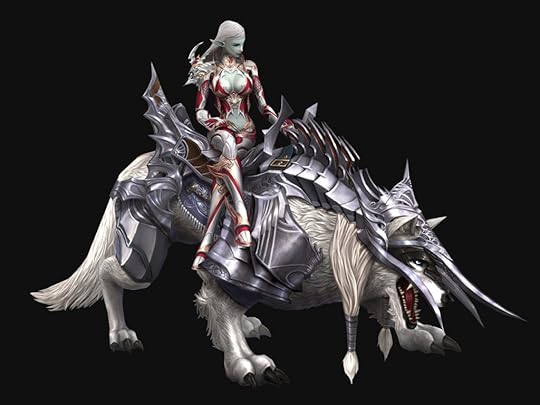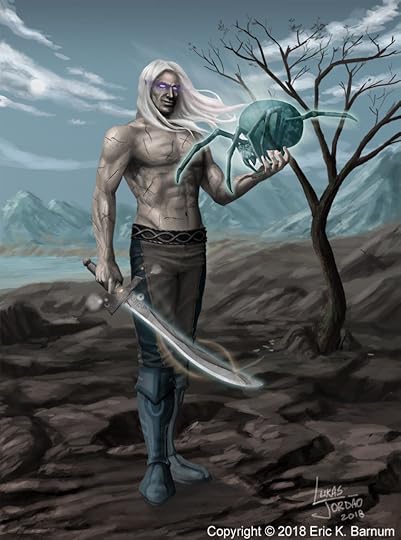FI’s Guide to the Dark Elves, or Drow
 Pronounced however you like it. I tend to say “He’s a Drow,” when referring to an individual so that it rhymes with “ow!” I say Drow, rhymes with “so what?” when referring to the race. Back in the good old Icewind Dale Trilogy when Drizzt was an outcast ranger, and before anyone cared about TSR’s ‘Fiend Folio,’ the Drow were anti-elves. They were every bit as diverse as other races. Drizzt came along and created an enduring archetype that has since made its way into almost every niche of fantasy. I blame World of Warcraft and Lineage Dark Souls for turning them into BDSM dominatrixes with a leather fetish. It looks cool, sure, but no race as long-lived and intelligent as any type of Elf would wear bikini armor and fishnets to war. It’s laughable. Within their own society, you might find this but as a form of worship? I sincerely doubt it.
Pronounced however you like it. I tend to say “He’s a Drow,” when referring to an individual so that it rhymes with “ow!” I say Drow, rhymes with “so what?” when referring to the race. Back in the good old Icewind Dale Trilogy when Drizzt was an outcast ranger, and before anyone cared about TSR’s ‘Fiend Folio,’ the Drow were anti-elves. They were every bit as diverse as other races. Drizzt came along and created an enduring archetype that has since made its way into almost every niche of fantasy. I blame World of Warcraft and Lineage Dark Souls for turning them into BDSM dominatrixes with a leather fetish. It looks cool, sure, but no race as long-lived and intelligent as any type of Elf would wear bikini armor and fishnets to war. It’s laughable. Within their own society, you might find this but as a form of worship? I sincerely doubt it.
This picture embodies everything I both love (cool art and I love the battle armor on the monster) and hate (weird sex harness armor) about fantasy dark elves in 2018.
For some fantasy stories and games, elves are a lazy way to interject diversity into the story. It’s less awkward to say, “He’s an elf,” than to say, “He’s a black-skinned elf.” Yet, wouldn’t it be expected to have some level of diversity within any race… especially if the setting allows for humans and elves to have children together? There should be a context.
Here is the Forsaken Isles context. So long ago it’s oral tradition even among elvenkind, there arose a schism between those who had become fascinated with magic (gray), civilization (high), nature (sylvan), and the dark arts. For a time, magic was just magic and one of the fastest ways to attain knowledge is through summoning and interrogating extraplanar creatures, like demons. We don’t know when it happened, but at some point, the majority said, “This is bad” and the practitioners of the dark arts said, “We don’t care; we’re going to keep doing this.” It resulted in what is called the Race Wars, that marked the formal beginning of different elven ‘types.’ The so-called Dark Elves left.
Eventually, those Dark Elves came back and were many times more powerful than the strongest of the ‘light’ elves. The Race Wars began again. Of note, many other races underwent similar upheavals in this time period. This is when dragons became confined in their current forms and breath weapons. This is when Orcs lost much of their power through their god Gruustir, who could not focus on sustaining the worship of Orc, goblin, ogre, and troll. This whole time period is called by mages: The Race Wars and marks the beginning of what most Tehrans would call Time. This second Race War was terrible. The ‘light’ elves only won by re-unifying under the leadership of the Gray Elves. The Dark Elves were barely expelled and hunted until they vanished.
Fleeing underground, the dark elves continued in their worship of demons always seeking the strongest demon, the one that would give them the most power. It was a societal contract that bound them when they eventually found Lolth. They were blessed with power, but at great personal price. Within their own society, they call this ‘The Maddening.’ It was a time when priests and mages rose up in tremendous power quickly, and drunk on that power the dark elves fell on each other. Lolth’s consort, Grazzt, ended this by offering a buffer. The worship of Lolth continued at a societal level but only the priestesses truly worship Lolth now… and they suffer The Maddening as part of that worship.
At some point, this underground empire shifted from Tehra towards Lolth. It is not in Tehra. By being even a fraction of a step closer to Lolth, the priestesses are exponentially powerful. When this happened, certain children suffered a strange form of ablinism where their hair became brilliant white or silver. Their skin turned completely black. Their eyes adjusted to see in the total dark. This first generation were considered avatars of Lolth and were named ‘Drow.’ All other dark elves can be called Drow, but they actually just look like a continuation of the defectors from Gray, High, and Sylvan sub-species.
Unlike their surface cousins, the Drow have no compunctions about having offspring with other races. They are so intermixed at this point, that half-Drow/other species are a sub-race to themselves. The only exception is that Drow females only bear Drow offspring. It is considered treason to do otherwise and the children are cast out or sacrified to Lolth depending on the social status of the female.
The Drow religion is matriarchal. The actual society is not. It is ruled by a high king, often titled as emperor. Priestesses of Lolth and paladins of Grazzt are afforded tremendous respect. They act like judge, jury, and executioner as they see fit though there is a rule of law… it is stilted towards the Drow, the Temple of Lolth, and then the dark elves. As per many fantasy tropes, the dark elves are a backbiting and stabbing society, yet they thrive because they do so through the sub-race proxies.
Whenever a family gathers enough wealth to sanctify a temple to Lolth and support a Great Mother Priestess, they are considered to be a great house. In the time of King Malcor aka Rojo II, there are Six Great Houses: Do Larus, Rudan, Pleidaran, Culfinrey, Djinfenrey, and Lanshar. There are many other houses, self-titled because of alliances with one of these six. The imperial house of Ka’ix (kai-icks) would be considered a seventh house. Each house has a specialization by which they are known. These are:
A royal lineage linked to the Race Wars and pre-Race Wars nobility within elvendom
A temple of Lolth, or many temples of Lolth. While one Great Mother tending to a temple is enough to be a Great House, it is not enough to hold power for very long
A military presence or alliance structure that allows them to hold onto their specialization
Land holdings on the surface of Merakor, and nexus gates by which to reach those lands
Part of the oral history of the Drow is that the surface elves forcibly expelled them because they were racist, ignorant, and belligerent. The Drow see it as their purpose to bring all elves into the worship of Lolth, by force if required.
More on the dark elves later. They are on my mind as I work my way through the outline and early chapters of Merakor II. I keep running into them as an over-used trope and cliche even so I put key to PC and vented that frustration so I can focus on the Drow of the Forsaken Isles.
 Daryx, dark elf ranger and member of the Circle of Morbatten
Daryx, dark elf ranger and member of the Circle of Morbatten



